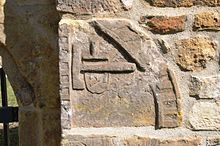Saint Petri Church (Wandersleben)
The St. Petri Church is the Protestant church in Wandersleben . It is a protected cultural monument in the district of Gotha and belongs to the parish Apfelstädt in church district Gotha of the Evangelical Church in Central Germany .
history
The church of St. Petri was originally Romanesque , as evidenced by walled-in Romanesque windows and a doorway from the same period. The church was first mentioned in a document in 1143. At that time, Wandersleben was named as the ecclesiastical administrative seat of the deanery, to which the parishes of Ermstedt , Kleinrettbach and Mühlberg also belonged. In 1527 the place became Protestant in the course of the Reformation by the Counts of Gleichen . Today's church stands on the Romanesque foundation walls.
The tower, which was presumably built in the 15th century, burned out in 1655 and in 1671 its upper area got its present appearance. It was in danger of collapsing before it was renovated in 1997. The roof, facade and organ were also renovated, not least thanks to the efforts of the church building association.
Church interior
The furnishings from the Baroque era are characterized by the organ from 1724 and the 15th century Annen Altar, a wood-carved winged altar that was walled in in the back of the church after the Reformation and only rediscovered in 1880. Also worth seeing is the life-size, late Gothic depiction of the crucified. There are some artistically valuable epitaphs in the church . The church served as a burial place for various local noble families until the 18th century . Among other things, there are the grave slabs of Countess Elisabeth von Gleichen , born in 1556 . Fr. von Plesse, wife of Count Georg von Gleichen and her daughter, Countess Elisabeth von Isenburg († 1616). In the 19th century a plaque with the coats of arms of the former Wandersleben aristocratic families was discovered.
In addition to church events (services, weddings, etc.), concerts are held in the church from time to time.
organ
The organ is a work by Johann Georg Schröter from 1724 with 23 stops on two manuals and a pedal . After several modifications and extensions, the instrument was restored in 1999 by Orgelbau Waltershausen . The disposition is:
|
|
|
||||||||||||||||||||||||||||||||||||||||||||||||||||||||||||
graveyard
The well-kept cemetery houses some old and historically interesting gravestones. So also that of Johann Christian von Henning (1692 to 1767), one of the owners of the Henningshof in the center of the village opposite the town hall. For safety reasons, among other things, the cemetery wall, which was in danger of collapsing, was renovated in September 2011 to the adjacent “Dreikäsehoch” kindergarten and the valuable portal there at the entrance to the church grounds was rebuilt.
Pictures of the church
- In the cemetery
Individual evidence
- ↑ [1] . The Church of St. Petri on the website of the evangelical parish Apfelstädt. Retrieved February 10, 2010.
- ↑ Information about the organ on orgbase.nl. Retrieved January 6, 2020 .
Web links
Coordinates: 50 ° 53 ′ 50.1 ″ N , 10 ° 51 ′ 15.7 ″ E
















